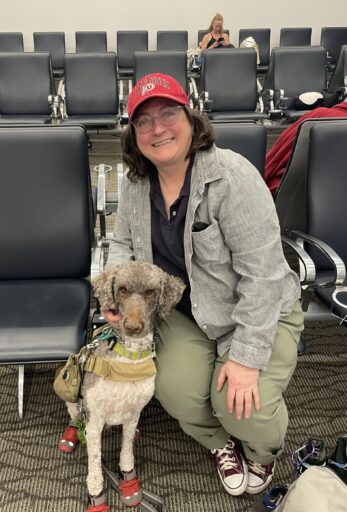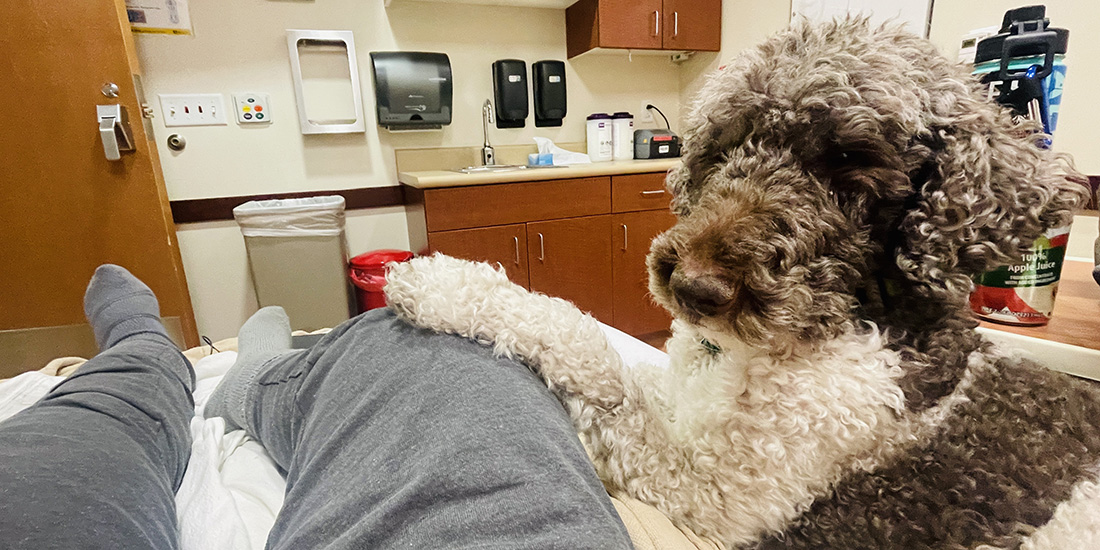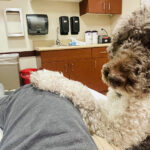When Susan Cohen’s service dog Wrangler, a 45-pound standard poodle, began acting strange during a recent hospital visit, it was not her vitals that tipped off the medical staff—it was her dog. A nurse noticed Wrangler’s sudden change in behavior and immediately called the physician. “They recognized something was wrong before I did,” said Cohen, who was later diagnosed with early signs of anaphylaxis (a life-threatening allergic reaction). “My dog potentially saved my life that day.”
Service dogs like Wrangler do far more than guide or retrieve—they are medical equipment, trained to monitor, alert, and even seek help as needed. For first responders, understanding these working dogs can mean the difference between life and death.

“Service dogs are trained to respond to very subtle changes in a handler’s body—things you or I might never notice,” said Mike Seely, a former dog trainer, in a personal interview with the author in April 2025. “It might be blood sugar, heart rate, or even seizures. And if you separate that dog from their handler in a crisis, you’ve just cut off their safety net.”
Despite their importance, service dogs often face barriers during emergencies. Handlers report challenges with everything from inaccessible parking to confusion at security checkpoints. Cohen, for example, struggled to get Wrangler out of her car after arriving at a hotel for a recent conference. “There were no accessible spots, and the regular spaces were so tight I had to back out just to open the door wide enough to unload my boy.”
Learn How to Identify Service Dogs
According to the Americans with Disabilities Act (ADA), service dogs are not required to wear identifying gear such as vests or tags. They also do not need to carry any certification or documentation. First responders and the public are legally allowed to ask only two questions: “Is that service dog required due to a disability?” and “What tasks is the dog trained to perform?”
“People are often shocked to learn there’s no official ID or certification,” Seely said. “But those vests and patches you see online, anyone can buy them. The real difference is in the behavior and the training.”
Meanwhile, fake service dogs—poorly trained pets with vests—can create dangerous situations and unfair skepticism for real teams. In most scenarios, true service dogs remain calm, focused, quiet, and responsive only to their handlers, even in chaotic environments, while fake service dogs may bark, lunge, seek attention, sniff everything, or show a lack of control that puts others at risk.
Cohen’s dog, for example, is trained to provide both medical alert and mobility support and has had extensive obedience training. Wrangler may paw her, kiss her face or even gently pull her hair to alert to a medical event. “It’s not affection—it’s communication,” Cohen said.

Allow Service Dogs in Ambulances
In emergency situations, service dogs should accompany their handlers in ambulances whenever possible. Under the ADA, service animals are allowed to remain with their handlers in public areas, including emergency transport, unless their presence interferes with medical care or creates a safety issue.
If space or care requirements prevent the dog from riding in the ambulance, alternative arrangements must be made to ensure the dog is transported safely and arrives at the same location as the handler, ideally with help from police, fire services, or trusted contacts.
Service dogs are trained to be calm, and for the most part, they will remain calm in any scenario. However, if one has not experienced an ambulance or emergency different from what they are used to (e.g., oxygen masks, defibrillators, stretchers, flashing lights, sirens), it is possible to become anxious. Be aware that unfamiliar stimuli when their handler is in distress could create a unique behavior. Stay calm, avoid direct eye contact or reaching over the dog, and use a calm voice if interaction is needed.
Avoid Common Mistakes With Service Dogs
Do not be alarmed by a dog’s vigilant behavior. A service dog may instinctively guard or block others from reaching their unconscious or disoriented handler, not out of aggression, but out of loyalty and training. This is known as a protective response. First responders should use calm, confident verbal cues, and if needed, work around the dog or enlist help from animal control or the handler (if possible) to move the dog without force.
Interact with the handler, not the dog. Service dogs are trained to ignore distractions. Even when lying down or appearing asleep, they are tuned into their handler’s breath, movement, and emotional state. Interacting with them, petting, calling to them, or giving commands can disrupt this crucial monitoring. If the handler is conscious, always interact with the handler and not the dog.
Do not ask to remove a dog’s vest. Many service dogs are trained to shift their behavior based on their gear. The vest means they are working. When it is off, they know they are off duty. That is why security personnel asking a handler to remove a dog’s vest can create serious confusion for the dog, essentially signals the job is done. In fact, Transportation Security Administration guidelines allow service dogs to keep their working gear on through screening, since removing it may interfere with their ability to perform tasks.
Do not separate a dog from its handler. In emergency shelters and hotels, federal law mandates that service dogs be allowed to stay without additional fees or separation from the handler. Denial of access is not just illegal—it could put the handler’s life at risk.
A well-trained service dog will not be noticed in restaurants or public places. “A trained service dog will blend into its surroundings and not be seen or noticed by everyone,” said Seeley.
Consider a service dog as lifesaving medical equipment and care for it accordingly. The cost and training involved in service dog work are immense. A fully trained dog may represent years of work and tens of thousands of dollars in training and care.
Handlers sometimes carry medical notes or training logs for convenience but are not legally obligated to show them. Cohen carries her own training logs and a doctor’s prescription—not because she must, but because she is tired of being questioned whether her dog is actually a trained service dog. If a patient is unconscious or confused, “First responders should check a service dog, as they may have information on them to aide medical personnel [as] to their handler’s condition, and the handler may also carry medications in [the dog’s] vest,” said Cherrise Baskett of Basket of Paws in Utah.
Let Service Dogs Be Your Partners
First responders are tasked with protecting lives in moments of disaster or crisis. Recognizing that service dogs are not pets, but skilled medical equipment should be part of that mission.
“When everything is falling apart, that dog is the one thing holding it together,” said Cohen. “We don’t just need them. We rely on them to survive.”

Susan Cohen
Susan Cohen, M.Ed., is a communications leader with many years of experience in journalism, public relations, marketing, strategic communication, and multimedia storytelling. She is currently a communications manager for a nonprofit organization that specializes in education resources and network infrastructure, supporting healthcare and education across Utah. Additionally, she teaches communications and visual arts at Salt Lake Community College. In her career, Susan has covered breaking news, natural disasters, and high-stakes events—experiences that deepened her respect for first responders and their critical role in keeping communities safe and informed. Armed with a master’s in educational psychology from the University of Utah, Susan combines strategic vision with frontline communication skills. She has seven years of experience working with her service dog Wrangler.
- Susan Cohenhttps://disasterpreparedness.kinsta.cloud/author/susan-cohen






